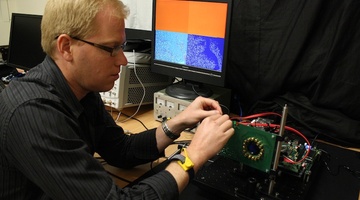Time-of-flight technology can be adapted to suit a variety of applications. Dr Adrian Dorrington from the School of Engineering at the University of Waikato explains some of the medical applications as well as user-interface control. For example, the shape of a person can be measured using time-of-flight cameras, and this could be of assistance in reconstructive surgery.
Transcript
DR ADRIAN DORRINGTON
So we can also use time-of-flight cameras for some medical applications. There are a couple of different ways. One is measuring the exterior of a person, so for perhaps a reconstructive surgery, and another is for treatment such as radiotherapy where the doctors want to direct a radiation beam onto a tumour. Now, this treatment is done repeatedly, and it’s important to get the person in the same position each time to try and target the tumour. So one way that we could help do that is by measuring the shape of the person and where they are in relation to the radiotherapy equipment and to ensure that they’re sitting or lying in the same position each time.
So one of the other big applications is in user-interface control or gaming control. If you have a look at some of the gaming consoles that are available at the moment, like the Wii, for example, or the new PlayStation, you need to hold a controller in order to interact with the game, but if you look at the Microsoft Connect controller, then you don’t need to hold a controller because the Connect camera is measuring the shape of people, and you can interact with the game or with anything else for that matter by just using gesture controls.
So with gesture controls, the 3D camera is very useful because if you were to use a normal camera for this, the computer can pick up movements side to side and up and down but it can’t detect movements towards or away from the camera, but with the time-of-flight 3D camera, because we’re measuring distance, we can also detect these movements towards and away from the camera.
The time-of-flight technology can be adapted to many applications, and what the camera looks like in a different application is dependent on what we need from that application. If you’ve got an industrial measurement situation like factory quality assurance and you want to know quite accurately the shape of something, then you’re probably going to need a camera that’s a reasonable size because it’s going to need a fairly big light source and it’s going to need a big lens. But if you’ve got a camera for a gaming application or a gesture control application where the accuracy is not all that important but perhaps speed of operation is more important, then the camera can be miniaturised, and eventually I think we’ll see these types of cameras in laptops as you’ll see a webcam today.
Acknowledgements
Certain images in this video are the copyrighted property of 123RF Limited, their Contributors or Licensed Partners and are being used with permission under license. These images may not be copied or downloaded without permission from 123RF Limited.
Jan Mehlich Creative Commons Attribution ShareAlike 3.0 GNU Free Documentation License
Waikato District Health Board


